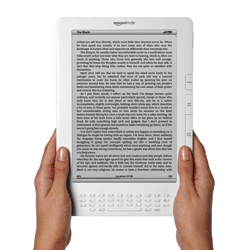But paper is not extinct
It is the new wave. Many people think that printed on paper is about to go away. Did you ever once see Spock hand Captain Kirk a piece of paper?
All bookstores will be shuttered, except a few antique stores. Publishers of magazines, like the one you are holding in your hand or viewing on your LCD, will be happy because they no longer have to pay for printing and postage, and all the people that printed and posted will have to find other jobs. An E-reader will provide all your books and periodicals electronically.

The folks at Amazon were kind enough to lend me a Kindle DX, the current top of the line in E-readers, for a couple of weeks. It sports a large and very crisp and clear 9.7-inch E Ink screen with 16 levels of gray and has some really cool features.
First off, when it arrives you open it up and you are already wirelessly connected. Magic. The connection is via a 3G/EVDO cell phone network that Amazon picks up the tab for. It is connected to the Amazon site and your account is all set up and ready to download one of their 335,000 books or sign up for a subscription to the San Francisco Chronicle , the New York Times , or one of 33 or so monthly magazines.
You can download a book for about $10 in about 1 minute. Very cool. This is very cool for Amazon (captive audience) and the user (get my paper delivered every morning and all my purchases are in one tidy spot), as long as you live in the cell coverage area. E-readers from other manufacturers are loaded from an Internet–connected computer, and the Kindle can do this to, but the cell connection is the cool thing.
The Kindle DX can hold a remarkable 3,500 books with its 4 gigs of internal flash. Now, there go all the bookshelves. Don’t get into the bookshelf business.
OK. So, after two weeks did I buy one? Nah, not yet. There are lots of people who love their Kindles, but it might be for the gadget factor or cool factor. One of the things people ask me right away is — what if you want to go back to find something that you read four days ago. Well, you go back one page at a time using the Prev Page button and when you find what you want you push the Next Page button until you get back to where you were. It takes a couple of seconds to turn a page — a pretty slow process. It is sooo unlike a newspaper, where one can easily scan through a bunch of articles. There is a bookmark you can assign anywhere, but it is not easy to get to.
I had the Kindle on my dresser and the Chronicle on my front step every morning, and the paper was the easy choice. The Kindle has an index of the sections in the paper — front page, sport, local news, etc., but it’s still to hard to get around. One nice thing is you can easily change the font size. And, when you “close” a book and open it again the next day it is right were you left off.
But, when you take it to the café and get up to get that second cup of coffee, you don’t leave it lay on the table. And you don’t take it to the bathtub with you either.
Maybe you have read about the incredibly ironic incident a while ago where Amazon deleted the George Orwell book 1984 (published in 1949) from Kindles without even notifying their owners. Apparently the publisher complained to Amazon that a number of electronic editions of Orwell books were pirated. So they just took them back. 1984 is about a totalitarian state that controls every aspect of life, even people’s thoughts (and newspapers, and books). You can ponder this.
Paper books and newspapers will be around quite a while — but readers will be increasingly popular — especially when they cost less than the $489 Kindle DX (the smaller Kindle 2 is $299). Please e-mail me with your ideas on this topic.
Jim Harrison
Advertisement
Learn more about Electronic Products Magazine





